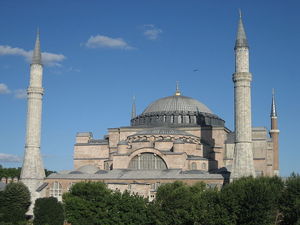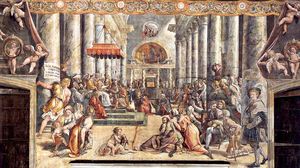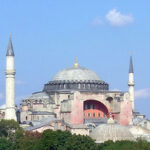Hagia Sophia, or Haghia Sophia, is a beautiful museum that was once one of the most magnificent Christian churches in the world. It resides in Istanbul, Turkey, formerly Constantinople. The structure is nearly 1500 years old. Time, war, nature and thievery have taken their toll on Hagia Sophia over these many years. However, conservation and restoration projects, some completed and some underway, are bringing Hagia Sophia back to at least a shadow of its former glory.
The site that Hagia Sophia occupies was first home to a church during the reign of Constantine the Great. The original church was destroyed and Constantine’s son commissioned another. In 532 A.D., during the Nika riots, that church burned down. That same year, Justinian I commissioned a new, better church. This church was the Hagia Sophia.
Hagia Sophia was designed by Isidore of Miletus and Anthemius of Tralles. One hundred and seven marble columns were placed inside of the spacious building. Today, the monogram of Justinian I and Theodora can still be seen near the top of them. Artists were brought in to make large mosaics throughout the church. The building was topped by a huge dome. It really was an engineering marvel during its time. Once the building was complete, the entire dome and ceiling was gilded. The process of building Hagia Sophia took only five years. It was not long before nature took its toll on Hagia Sophia. However, it was always restored well during its time as a Christian church.
In 1204, Crusaders took everything they could from Hagia Sophia. They were simply passing through on their way to the ‘Holy Land.’ Looking back on the crusades, it is hard to understand how anyone accepted the excuses of these violent crusaders. Firstly, Hagia Sophia was a Christian church. However, different Christian sects were intolerant of each other. It makes about as much sense as today’s holy wars. Secondly, a common phrase that we hear connected to Crusaders is “God wills it.” That makes you wonder if these Crusaders genuinely thought that god had willed them to steal, or if they were greedy and making excuses. Either way, they stole many items from Hagia Sophia. Therefore, much of what was once held in the church has been adopted and put on display by other countries.
For more than 200 years, the Hagia Sophia was left in relative peace. Of course, there was time and weather to contend with, but there were no more invaders until 1453. On May 28 of that year, Emperor Constantine XI took his last communion at Hagia Sophia, mere hours before the once great Constantinople was conquered by the Ottoman Turks. Sultan Mehmet II conquered the city and took Hagia Sophia. The interior of the church was changed to suit the conqueror’s beliefs. Parts of the mosaics were covered in plaster, four minarets were added to the exterior and the church was converted to a mosque. It remained as such for nearly 500 years.
Hagia Sophia was made into a museum in 1934. It is no longer a place of worship for any religion. However, it is still a great place visit and enjoy some history. Restorations have brought the former church back to some of its original splendor and there is still plenty of religious iconography there. Therefore, if you are a history buff, religious, or both, Hagia Sophia will interest you.
Sources
Hayes, Holly, Hagia Sophia, Istanbul, retrieved 4/29/10, sacred-destinations.com/turkey/istanbul-hagia-sophia
Harper, James & Westwood, The Atlas of Legendary Places, pages 150-153, Konecky & Konecky, 2003








